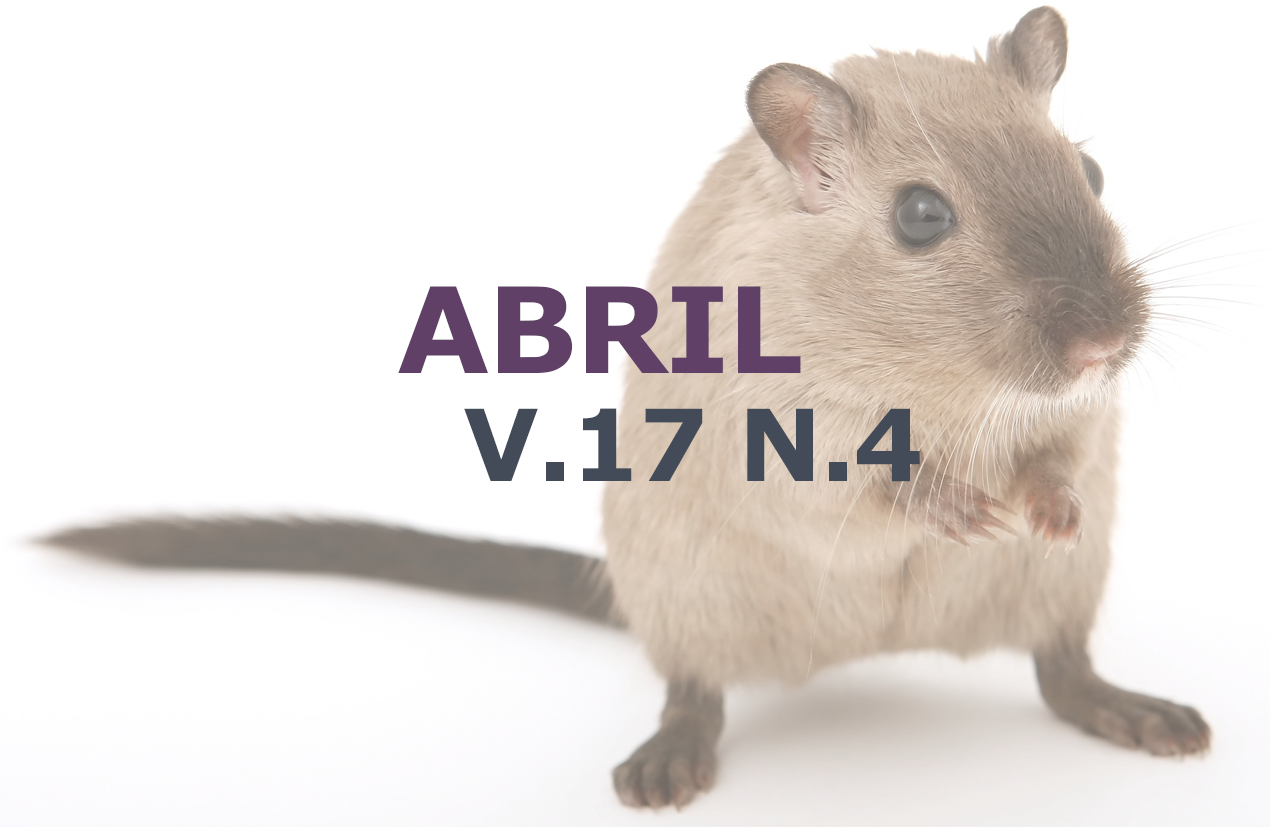Cardiomiopatia dilatada em cão com hipotireoidismo e megaesôfago
DOI:
https://doi.org/10.31533/pubvet.v17n04e1366Palavras-chave:
insuficiência cardíaca congestiva, hipomotilidade, síndrome de Hashimoto, fração de encurtamento reduzidaResumo
A cardiomiopatia dilatada é caracterizada pela deficiência de contração ventricular e sabe-se que diversas afecções podem causar com a baixa contratilidade miocárdica e consequente dilatação das câmaras cardíacas. O hipotireoidismo é uma endocrinopatia que pode estar relacionado à diminuição da contratilidade muscular, como da musculatura miocárdica e esofágica. O objetivo desde trabalho foi relatar um caso de um cão com hipotireoidismo, megaesôfago e cardiomiopatia dilatada. Foi atendido um paciente canino, macho, Fila Brasileiro, oito anos de idade e escore de condição corporal (ECC) 2 (1-9), apresentando queixa principal de dispneia, regurgitação, fraqueza, edema de membros, emagrecimento progressivo, hipotricose e alopecia bilateral simétrica em tronco e cauda. Ao exame físico pode-se constatar impressão de godet, crepitação pulmonar, sopro sistólico grau IV (I-VI) e desidratação de 8%. Foram realizados exames complementares, como radiografia torácica, ecodopplercardiograma e dosagem sérica de T4 livre por diálise e TSH. Assim, foi confirmada a presença de cardiomiopatia dilatada em insuficiência cardíaca congestiva, megaesôfago e hipotireoidismo. Foi instituída a terapia paliativa para estabilização do paciente e iniciado tratamento específico para as afecções por via oral com pimobendan, benazepril, furosemida, espironolactona, levotiroxina sódica, administrados em posição bipedal, além do manejo alimentar com alimentação pastosa também em posicionamento bipedal por 20 minutos. Com um mês de tratamento, o paciente apresentou melhora clínica, ganho de peso (ECC 3) e crescimento dos pelos. Todavia, o tutor declinou a realização de exames de acompanhamento hormonal, sendo mantida as doses inicialmente prescritas. O diagnóstico precoce, a instituição do tratamento adequado e o acompanhamento do paciente frente a terapia instituída são de extrema importância para a estabilização do paciente e a manutenção da homeostasia do organismo, aumentando a qualidade e expectativa de vida dos pacientes
Referências
Alves, N. M., Dias, T. P., Pereira, A. M., Rosito, J., & Borges, M. M. (2013). Megaesôfago congênito em cão. PUBVET, 7, 2327–2445.
Barone, G. (2015). Tratado de medicina veterinária. Guanabara Koogan S.A.
Bilhalva, M. A. et al. Hipotireoidismo canino e seus efeitos sobre o sistema cardiovascular. PUBVET. V.14, n.4, a542, p.1-6, abr., 2020.
Boscarato, A. G., Alberton, L. R., Komochena, H. A. E. S., Botelho, E., Ribeiro, R. de C. L., Orlandini, C. F., & Steiner, D. (2016). Esporotricose equina e hipotireoidismo iatrogênico. Acta Scientiae Veterinariae, 44, 1–6.
Chaves, R. O., Schwab, M. L., Ripplinger, A., Copat, B., Aiello, G., Ferrarin, D. A., Flores, M. M., Fighera, R., & Mazzanti, A. (2017). Central vestibular disease due to ischemic stroke secondary to hypothyroidism in a dog. Acta Scientiae Veterinariae, 45(Supplement 1).
Ettinger, S. J., Feldman, E. C., & Cote, E. (2017). Textbook of Veterinary Internal Medicine-eBook. Elsevier Health Sciences.
Hoskins, J. D. (2008). Geriatria e Gerontologia do cão e do gato. Editora Roca.
Leal, P. D. S., Almeida, E. C. P. A., & Lopes, C. W. G. (2016). Diagnóstico de dermatopatia piogranulomatosa por Nocardia spp. numa cadela Labrador Retriever com hipotireoidismo, Rio de Janeiro, Brasil-Relato de caso. Brazilian Journal of Veterinary Medicine, 38(2), 203–209.
Mora, J. M., Pérez, E., & Millán, R. (2006). Trombo intraventricular izquierdo en un gato con cardiomiopatía dilatada. Clínica Veterinaria de Pequeños Animales, 26(2), 130–135.
Moreira, L. F., Kinappe, L. F. G., Duhart, D. G. M., & Motta, A. de S. (2018). A geriatria canina e o manejo das doenças neoplásicas: Revisão. PUBVET, 12(4), 1–7. https://doi.org/10.22256/pubvet.v12n4a79.1-7.
Muzzi,R.A.L. et al. Cardiomiopatia dilatada em cão: Relato de caso. Ciência Rural. Santa Maria, v. 30, n. 2, p. 355-358, 2000.
Nelson, R. (2011). Medicina interna de pequenos animais. Elsevier Brasil.
Oliveira, W. J., Germano, P. C., Endrigh, M., da Costa, B. N., Bueno, A. L. B., Barbosa, C. K., de Sousa, R. S., de Oliveira Stedile, S. T., & Sousa, M. G. (2022). Tromboembolismo arterial em felino decorrente de cardiomiopatia restritiva: Relato de caso. PUBVET, 16(11), 1–9. https://doi.org/10.31533/pubvet.v16n11a1266.1-9.
Orton, C. E. (1997). Surgery of cardiovascular system. In Small animal surgery (pp. 575–608). Fossum, T W.
Souza, I. R., Bomfim, L. T., Dias, S. R. M., & Santos, K. L. O. (2022). Megaesôfago em cães: Revisão. PUBVET, 16(3), 1–6. https://doi.org/10.31533/pubvet.v16n03a1059.1-6.
Strey, S., Mischke, R., & Rieder, J. (2021). Hypothyroidism in dogs: an overview. Tierarztliche Praxis. Ausgabe K, Kleintiere/Heimtiere, 49(3), 195–205. https://doi.org/10.1055/a-1367-3387.
Tanaka, N. M., Hoogevonink, N., Tucholski, Â. P., Trapp, S. M., & Frehse, M. S. (2010). Megaesôfago em cães. Revista Acadêmica Ciência Animal, 8(3), 271–279.
Tostes, R. A., Reis, S. T. J., & Castilho, V. V. (2017). Tratado de medicina veterinária legal (Vol. 1). MedVep.
Downloads
Publicado
Edição
Seção
Licença
Copyright (c) 2023 Rebeka Ferro Tosta Kalil

Este trabalho está licenciado sob uma licença Creative Commons Attribution 4.0 International License.
Você tem o direito de:
Compartilhar — copiar e redistribuir o material em qualquer suporte ou formato
Adaptar — remixar, transformar, e criar a partir do material para qualquer fim, mesmo que comercial.
O licenciante não pode revogar estes direitos desde que você respeite os termos da licença. De acordo com os termos seguintes:
Atribuição
— Você deve dar o crédito apropriado, prover um link para a licença e indicar se mudanças foram feitas. Você deve fazê-lo em qualquer circunstância razoável, mas de nenhuma maneira que sugira que o licenciante apoia você ou o seu uso. Sem restrições adicionais
— Você não pode aplicar termos jurídicos ou medidas de caráter tecnológico que restrinjam legalmente outros de fazerem algo que a licença permita.





